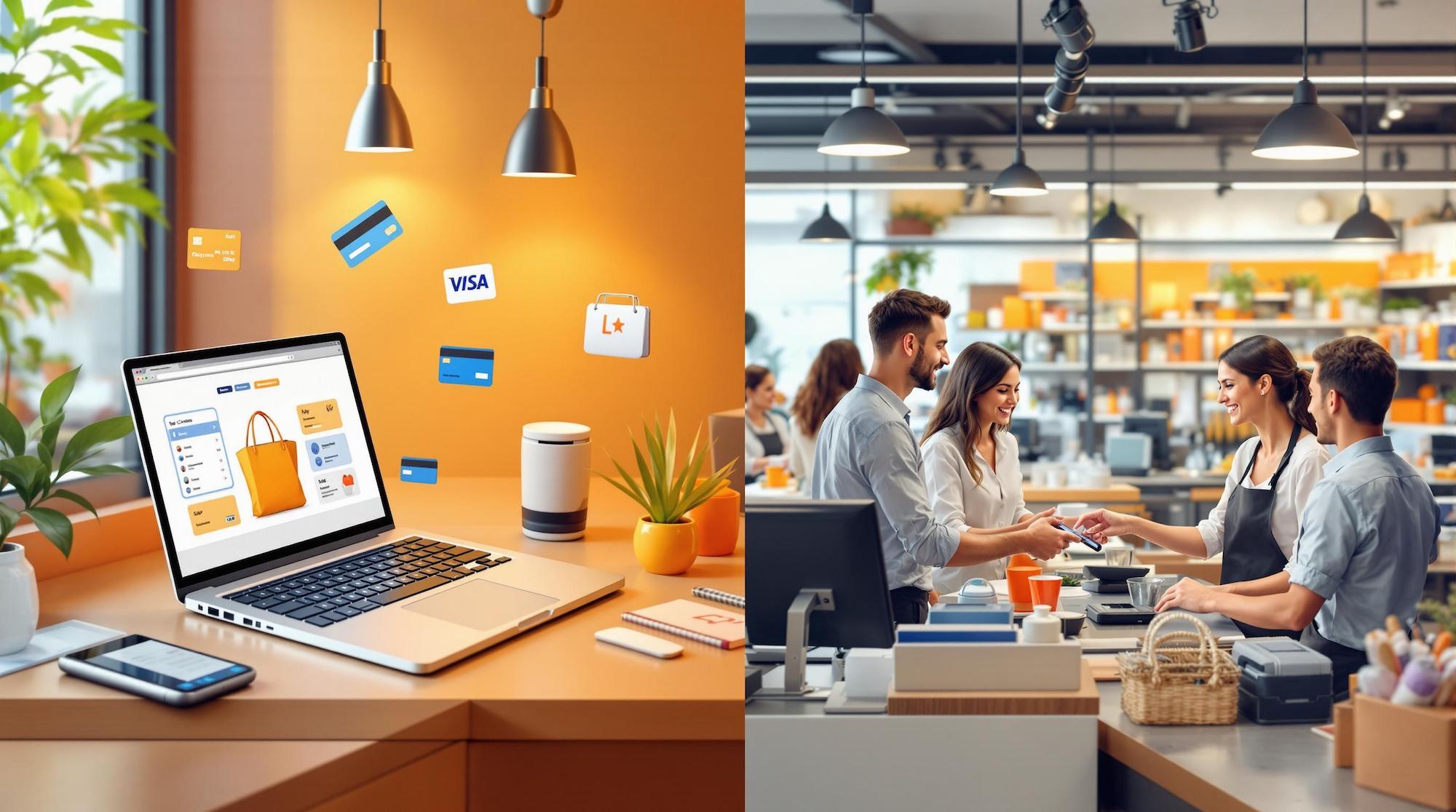Choosing between e-commerce and in-store payment processing depends on your business model, customer preferences, and growth plans. Here’s a quick breakdown:
-
E-commerce Payment Systems:
- Accept payments online 24/7.
- Reach global customers.
- Lower operational costs but higher fraud risks and cross-border challenges.
- Requires tools like payment gateways and inventory integration.
-
In-Store Payment Systems:
- Face-to-face transactions with immediate product access.
- Personalized service and instant purchases.
- Higher equipment costs and complex fee structures.
- Needs POS systems and secure payment terminals.
Quick Comparison
| Aspect | E-commerce | In-Store |
|---|---|---|
| Market Reach | Global accessibility | Local presence |
| Customer Experience | 24/7 convenience | Hands-on interaction |
| Operational Costs | Lower, but includes tech setup | High initial equipment costs |
| Security | Higher fraud risk | Safer (EMV chip tech) |
| Payment Options | Digital wallets, cards | Cash, cards, mobile wallets |
| Scalability | Rapid, global growth | Location-dependent expansion |
Bottom Line: For global reach and lower costs, go e-commerce. For personal interaction and instant sales, choose in-store. Many businesses combine both to maximize flexibility and customer satisfaction.
Main Differences in Payment Processing
What Each Method Does
E-commerce payment processing handles online orders, digital payments, and order fulfillment through integrated platforms. On the other hand, in-store payment processing happens at physical locations using Point of Sale (POS) systems. These systems support face-to-face transactions, manage inventory, track sales, and provide immediate transaction confirmations. These differences lead to distinct technical requirements for each method.
Required Equipment and Systems
The tools and systems needed for each payment method reflect their unique settings:
| Payment Method | Essential Equipment | Technical Needs |
|---|---|---|
| E-commerce | E-commerce platform | Payment gateway and inventory system integration |
| In-store | Cloud-based POS system | Real-time payment and inventory tracking |
Cloud-based POS systems simplify operations by linking online and offline inventory, removing the need for manual updates.
How Customers Pay
Payment habits vary significantly between online and in-store shopping. For e-commerce, customers often use credit/debit cards and digital wallets. In fact, digital wallets in the US have been as popular as credit cards since 2020 [1]. Mobile payments are also on the rise, projected to account for over 43% of retail e-commerce sales in 2023 [1].
In physical stores, payments are typically made with credit/debit cards, cash, mobile wallets, or contactless options. Businesses combining online and offline payment methods see clear benefits – small businesses offering diverse payment options have experienced revenue growth of nearly 30% [1]. Meeting these varied preferences is crucial to align with what US consumers expect.
E-commerce Payment Processing: Pros and Cons
Advantages
E-commerce payment processing allows businesses to accept payments from customers around the world, eliminating geographical barriers and cutting operational costs [3]. These platforms support a variety of payment options – from credit cards to digital wallets – catering to customer preferences and reducing the likelihood of cart abandonment [4]. Additionally, transaction data provides valuable insights into customer behavior and purchasing trends, helping businesses make smarter decisions about inventory, pricing, and marketing.
Limitations
Despite its benefits, e-commerce payment processing comes with challenges. Online transactions are more prone to fraud since there’s no physical verification involved [3]. Integrating the necessary technical systems can also be tricky – issues between hardware and software components can lead to delays, lost transactions, or unexpected fees [3].
Cross-border payments introduce further complications, such as slower processing times, currency conversion fees, and complex banking requirements for handling multiple currencies [3]. The table below summarizes these advantages and challenges.
E-commerce Payment Summary Table
| Aspect | Benefits | Challenges |
|---|---|---|
| Market Access | Accept payments globally | Complications with cross-border transactions |
| Cost Structure | Reduced operational costs | Currency conversion and related fees |
| Security | Fraud detection systems in place | Higher fraud risk without physical verification |
| Technical Requirements | Streamlined automation and analytics | Complex integration and ongoing maintenance |
| Payment Options | Supports various payment methods | Each method may require separate integration |
| Customer Experience | 24/7 purchasing convenience | No face-to-face interaction |
To overcome these challenges, businesses should invest in strong multi-currency systems and implement strict security protocols. This includes fraud detection tools, regular audits, and timely updates to software, helping to reduce risks and maximize the benefits of e-commerce payment systems [5].
E-Commerce Credit Card Processing: The Ultimate Guide for …
sbb-itb-8c45743
In-Store Payment Processing: Pros and Cons
In-store payment processing shifts the focus from digital convenience to the hands-on, immediate experience of shopping in a physical location.
Advantages
In-store payment processing enhances the appeal of brick-and-mortar stores. Seventy-eight percent of shoppers prefer visiting physical stores because they can see and feel products before buying, and they appreciate the trust built through face-to-face interactions. Additionally, 65% of consumers value the instant gratification of taking their purchases home immediately [6]. Store associates play a key role by offering tailored recommendations and demonstrating products, creating a more engaging shopping experience.
Limitations
However, this method comes with challenges. Retailers often face complex fee structures that include interchange, merchant, flat, PCI, and chargeback fees, which can strain budgets [7]. The upfront costs for payment terminals, point-of-sale systems, and security equipment are also significant. On top of that, businesses must cover ongoing expenses like PCI compliance and system maintenance [7]. Handling cash introduces additional risks, including theft and errors [7].
In-Store Payment Summary Table
Here’s a quick breakdown of the pros and cons:
| Aspect | Benefits | Challenges |
|---|---|---|
| Customer Experience | Hands-on product interaction and instant purchases | Limited scalability and operational inconsistencies |
| Operational Costs | High initial equipment costs and complicated fee structures (e.g., interchange, merchant, PCI, chargebacks) [7] | |
| Customer Service | Personalized, face-to-face assistance | |
| Cash Handling | Increased risk of theft and transaction errors |
To make the most of in-store payment processing, retailers should focus on creating engaging experiences with well-trained staff and interactive displays [6]. Reviewing statements to cut unnecessary fees and negotiating better rates can also help manage costs effectively.
How to Choose Your Payment Method
Selecting the right payment solution is crucial for meeting your business needs. Here’s what to consider:
Fee Structures
Understanding payment processing fees is key to making an informed decision. Credit card fees usually range from 1.5% to 3.5% of the transaction amount [8]. Break down the costs to evaluate the overall value:
| Fee Component | E-commerce | In-Store |
|---|---|---|
| Interchange Fees | Higher (card-not-present) | Lower (card-present) |
| Assessment Fees | Standard card network fees | Standard card network fees |
| Provider Markup | Varies by provider | Varies by provider |
Online transactions often cost more due to higher risks. For example, Visa‘s interchange fees range from 1.15% + $0.05 for in-store purchases to 2.40% + $0.10 for online payments [8].
Next, ensure your payment method meets essential security standards.
Safety Requirements
Digital security is non-negotiable, especially when online fraud led to $48 billion in losses globally in 2023 [9]. For online businesses, prioritize:
- SSL/TLS encryption
- Multi-factor authentication (MFA)
- 3-D Secure protocols
- Tokenization
Physical stores should focus on secure payment terminals and EMV chip technology to reduce fraud risks. These measures protect your transactions and ensure compliance.
Growth and Expansion Options
Integrated payment systems are essential for businesses looking to grow across both online and in-store channels. They simplify operations and enhance customer experience.
"With an integrated POS, customers can enjoy the convenience of purchasing products online and picking them up in-store or returning items bought online at a physical location. This flexibility improves customer satisfaction and encourages repeat business" [10].
Key growth considerations include:
| Growth Factor | E-commerce Capability | In-Store Capability |
|---|---|---|
| Market Reach | Global accessibility | Local presence |
| Inventory Management | Cloud integration | Physical stock control |
| Customer Data | Digital analytics | Face-to-face feedback |
| Scalability | Rapid expansion | Location-dependent |
Cloud-based systems make it easier to integrate online and offline operations, allowing your business to scale efficiently [10].
These points will help you choose a payment method that aligns with your goals.
Business Examples and Solutions
This section looks at practical cases where businesses have successfully implemented payment processing systems.
Small Store Example
Mike’s Hardware, a store in Portland, Oregon, upgraded to a cloud-based POS system with an open payment gateway. This upgrade allowed for real-time inventory tracking, digital rewards integration, and multiple payment options like contactless, chip, and mobile payments. These changes helped streamline operations and create a better shopping experience for customers [11].
Online Store Example
Fresh Pantry, an online grocery retailer, adopted measures like robust encryption, multi-factor authentication, guest checkout, tokenization, 3-D Secure, address verification, and advanced fraud monitoring. These steps ensure secure and smooth transactions. With 58% of U.S. shoppers now comfortable purchasing groceries online [2], providing a secure and hassle-free payment process has become essential.
Combined Store Example
SportGear Pro successfully connected its online and physical stores using a unified POS system [10]. Key features include:
- Real-time inventory updates
- Unified customer profiles
- Easier returns processing
- A BOPIS (Buy Online, Pick Up In-Store) option
This integration automates critical tasks like updating stock levels, managing orders, and adjusting pricing across platforms. By reducing manual work and errors, the system enhances both operational efficiency and customer satisfaction [12]. These examples show how tailored payment solutions can meet the needs of different business types.
Conclusion
Key Takeaways
Payment processing is changing rapidly, with both e-commerce and in-store methods offering distinct advantages. Online sales are projected to surpass retail sales between 2023 and 2027 [10], making it more important than ever to select the right payment systems.
Merging Online and In-Store Methods
For retailers, combining online and in-store payment systems is often the key to success. As one expert puts it, "The retail world is an omnichannel world… This means that the more unified your experience is, the more opportunities you’ll be able to create to connect with customers and make that sale" [10]. A unified system not only simplifies operations but also improves customer satisfaction across all sales channels.
Steps to Implement a Unified Payment System
To set up a seamless payment solution, follow these steps:
- Assess your current system: Determine if it supports both online and offline integration.
- Select compatible tools: Find solutions that link your e-commerce platform with your in-store POS system.
- Plan the integration process: Map out how these systems will work together for smooth operations.
"A connected POS system means less work for merchants and a constant flow of data and information between the online and offline ecosystems. Merchants can essentially access all of their information in one place" [10].
- Test and maintain: Before going live, test your system thoroughly and ensure regular maintenance.
Choosing the right solution can make a big difference. Focus on systems that are secure, efficient, and capable of growing alongside your business. A seamless payment experience benefits both your operations and your customers.




